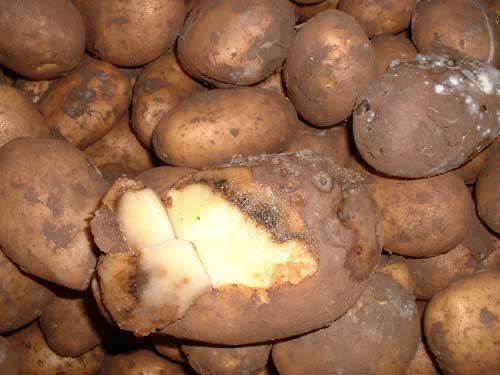
As the maincrop moves beyond tuber initiation, now is the time to move onto fungicides that have proven foliar and tuber blight activity, says Gowan Comércio.
"Once tubers start to form, they are at risk from zoospores that are the causal agents of tuber blight. Each infected plant can release millions of zoospores when the conditions are right. These zoospores are released or are washed down by rainsplash from the foliage into the soil and cause infection by germinating close to the tuber and entering access points such as buds, lenticels and wounds. The blight fungus then spreads within the tuber and starts to breaks down cellular tissue. You only need a few zoospores to reach potato tubers to suffer significant and damaging blight infections. Symptoms are usually seen within one month of lifting, but the disease must be prevented in the field as soon as the crop is vulnerable to attack and well before the infected tubers get into store," explains John Edmonds, European Technical Manager for Gowan Comércio.
"Not all blight fungicides have proven zoospore activity, but those that do need to be used in a specific way according to how they work. Zoxium® in Electis® and Roxam®, for example, stops zoospore formation and release, resulting in non-viable spores, which are incapable of infecting tubers. By reducing the zoospore loading in the crop as early as possible, Electis® will optimize the activity of other fungicides that have more direct zoospore activity," says John.
John explains that other blight fungicides such as fluazinam, cyazofamid or fluopicolide + propamocarb act directly on zoospores once they are released, preventing them from reaching tubers. Such products would be beneficial once Electis® has been applied, he says.
According to John, growers cannot and should not rely on just foliar blight control to prevent tuber blight. "Crop foliage must be protected by robust blight fungicides that have proven zoospore activity. This is particularly so as tubers are vulnerable to blight from tuber initiation, which is defined as when the tuber is twice the diameter of the attached stolon, onwards. This vulnerable stage normally starts around three weeks after crop emergence."
He warns that many crops are already showing signs of Alternaria or early blight in the field and that Electis® has one of the highest ratings for the control of this disease, as well as one of the best ratings for protectant activity against late blight plus a very acceptable rating for tuber blight. "So there is no need to go to the trouble or expense of a separate treatment for Alternaria."
"Even with lower blight pressure, as is the case this season so far, it remains important to keep spray intervals tight right up to desiccation. Electis® can be used up to 10 times in the season, important when regular applications are being made. It also gives growers much better flexibility as to how they integrate this fungicide into their programmes for effective foliar and tuber blight control, additional Alternaria activity and as a resistance management strategy."
END
For further information, please contact John Edmonds, European Technical Manager for Gowan Comércio on 01223 506 606 or 07764 268 199 (mobile).
Editors Notes: Electis® and Roxam® contain 8.3% w/w Zoxium® (zoxamide) and 66.7% w/w mancozeb, formulated as a WDG. They are recommended on all varieties of potatoes at spray intervals of 7 to 14 days. They have a dose rate of 1.8 kg/ha in 200-600 litres of water per hectare. They have a maximum number of treatments of 10 per crop and a harvest interval of 7 days. They are packed in a 3-ha pack (5.4 kg).
Electis®, Roxam® and Zoxium® are registered trademarks of Gowan Comércio.
